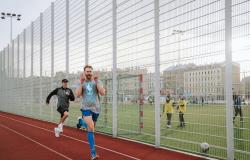What do we know about vimba?
Experienced fish researchers Jānis Birzaks, Jānis Peslaks, Ēvalds Urtāns and Āriks Aleksējevs have shared their thoughts about flounder in Latvian waters in the second half of the nineties of the last century. They are fish of the carp family, which are often found in the North Sea and Baltic Sea basins from Elba to southern Sweden. Vimba spends most of its life in coastal waters, but spawns by entering rivers. The Daugava was the largest spawning river before the Riga HPP was built. Now, their spawning downstream of the dam is effectively fruitless due to large fluctuations in water levels. In the water reservoirs of the Pļaviņi, Ķegum and Riga power stations, there are a small number of vimbas that have remained there, which have adapted to the local living conditions and no longer travel to the sea.
Vimba is the queen of the waters – its body is slender, of medium height, flattened from the sides. There is a distinct wedge on the back between the dorsal and caudal fins. The mouth is pointing down. The back is grayish bluish, the sides and belly are silvery white. Pectoral, ventral and anal fins – yellowish, dorsal and tail fins – greyish. During spawning, the body of the vimba becomes dark gray, the fins are brighter, males develop small protrusions on their head and body – spawning warts. Body length – up to 50 centimeters, weight – up to 2 kilograms, but the most common vimbas are 30-55 centimeters long and weigh up to 800 grams. Lives in flocks, sexual maturity occurs in the sixth or seventh year of life, and vimba can spawn several times in a lifetime.
How do vimbas spawn?
The entry of vimbus into the rivers takes place in autumn or spring, depending on sexual maturity. The vimbas that arrived in autumn usually spend the winter in the middle part of the river course and go to the spawning grounds in the upper reaches of the river in early spring. In the spring, those who have arrived are already mature and spawn in the middle and lower reaches of the rivers. A pebbly, rocky bed and a fast current are most often chosen as spawning grounds. Males prepare spawning grounds – small areas by cleaning mud deposits from the bottom. The fecundity of Vimbu females varies from 30 to 80 thousand eggs, depending on their body weight. They mature in batches, and the females release them two or three times with an interval of several days.
Vimbas spawn in May and June, when the water temperature does not fall below 13-14 degrees for several days. Larvae hatch from the eggs after 4-6 days, then they sleep peacefully for another 8-10 days and develop by absorbing the yolk sac of the larva. Developed larvae begin to actively swim and feed on tiny plankton creatures. Vimbu babies stay along river banks where there is no current. In the rivers, the babies live mainly until the spring of the following year, reaching a length of about 4-6 centimeters and a weight of 1-2 grams. Having entered the coastal waters of the Gulf of Riga, they mostly go to Pärnu Bay, grow there and, having reached sexual maturity, travel back to our rivers to spawn.
It should be noted that vimbas do not have a strong instinct to return to the same river where they were hatched. After spawning in our rivers, the majority of vimbus go back to Pärnu Bay, Matsalu and Muhu islands area, where there are better conditions for feeding and wintering. Vimbas feed mainly on small molluscs, various larvae and worms.
Where have the vimbas gone?
If vimbas are still a springtime novelty in fishermen’s catches, coastal fishermen already call them a disappearing delicacy. But has it always been this way? The “Latvijas Zivvārīga 1996/97 Yearbook” allows us to take a look at the statistics of the end of the last century: “In recent years, the fishing intensity of vimbus has increased significantly, because since 1992 nets have been used in large numbers in coastal fishing and, therefore, fishing has been done in places where no one fished in previous years. In the last five years, catches have fluctuated between 36 and 53 tons per year, but compared to catches ten years ago, they have halved. Vimbas are mainly caught with fish traps and nets, less with other fishing gear. In 1996, 50 tons of vimbus were caught in the coastal waters of Latvia, including 46 tons on the coast of the Gulf of Riga, and four tons on the coast of the Baltic Sea.”
At that time, at the beginning of the year, fish were intensively caught with nets under the ice in the fresh waters adjacent to the bay – Lielupe, Buļļupe and Daugava, where they had gathered for the winter. At sea, vimbas were mostly caught in the southeastern coastal waters of the Gulf of Riga, especially in the fishing area from Carnikava to Jurmala. About 43 percent of the total catch of 1996 was obtained there, and from Ainaži to Pabaži – about 30 percent. In the coastal waters of Kurzeme, the catches of vimbus were smaller. It should be noted that during this time, Estonian fishermen also intensively fished the stocks of vimbu in the Gulf of Riga in their own waters – Pärnu Bay and the fishing areas closest to it, especially in autumn and winter (in 1996, Estonia caught 155 tons of vimbu in the Gulf of Riga).
In this century, the statistics are much grimmer. Vimbu catch decreased from 17 tons in 2003 to 5 tons in 2015. A year later, in the then Salacgrivas district, coastal residents caught 3.7 tons of vimbu, fishing mainly with fish nets. Only 0.5 tons of vimbus were caught in the Murdu catch in the county that year. Salacgrīva fisherman Visvaldis Shrenks, who has been behind him for eight decades, admits that vimbu is becoming less and less every year, although there is a very high demand for smoked ones in the market. Smoked vimbas are considered the “nail” of the Fishermen’s Day treat, because neither the asaka nor the careful and slow eating of the fish deters the visiting locals.
(The conclusion will follow.)







